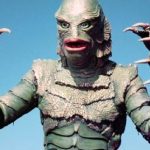 Movies and TV
Movies and TV  Movies and TV
Movies and TV  Health
Health 10 Miraculous Advances Toward Curing Incurable Diseases
 Miscellaneous
Miscellaneous 10 Undeniable Signs That People’s Views of Mushrooms Are Changing
 Animals
Animals 10 Strange Attempts to Smuggle Animals
 Travel
Travel 10 Natural Rock Formations That Will Make You Do a Double Take
 Movies and TV
Movies and TV 10 Actors Hidden in Your Favorite Movies
 Our World
Our World 10 Science Facts That Will Change How You Look at the World
 Pop Culture
Pop Culture 10 Incredible Female Comic Book Artists
 Crime
Crime 10 Terrifying Serial Killers from Centuries Ago
 Technology
Technology 10 Hilariously Over-Engineered Solutions to Simple Problems
 Movies and TV
Movies and TV 10 Movie Adaptions That Brought Popular Songs to Life
 Health
Health 10 Miraculous Advances Toward Curing Incurable Diseases
 Miscellaneous
Miscellaneous 10 Undeniable Signs That People’s Views of Mushrooms Are Changing
Who's Behind Listverse?

Jamie Frater
Head Editor
Jamie founded Listverse due to an insatiable desire to share fascinating, obscure, and bizarre facts. He has been a guest speaker on numerous national radio and television stations and is a five time published author.
More About Us Animals
Animals 10 Strange Attempts to Smuggle Animals
 Travel
Travel 10 Natural Rock Formations That Will Make You Do a Double Take
 Movies and TV
Movies and TV 10 Actors Hidden in Your Favorite Movies
 Our World
Our World 10 Science Facts That Will Change How You Look at the World
 Pop Culture
Pop Culture 10 Incredible Female Comic Book Artists
 Crime
Crime 10 Terrifying Serial Killers from Centuries Ago
 Technology
Technology 10 Hilariously Over-Engineered Solutions to Simple Problems
10 People Who Never Made Money off Their Creations
Just because you come up with a winning idea does not automatically mean it will make you rich. In most cases, creativity and ingenuity need to be paired with business acumen in order to result in large fortunes. History is filled with people who made almost no money off creations that were worth millions, even billions of dollars.
Here are ten cases where the inventor lost out and made no real money off their invention.
Related: Top 10 Dumb Inventions That Made a Millionaire
10 Gregory Coleman
If you are a professional drummer, then it’s guaranteed that, at one point in your life, you played the “Amen break.” Some have called this the most important seven seconds of music ever recorded. While this might be a bit of hyperbole, there is no denying that the short drum break, originally inserted only to fill time, turned into one of the most sampled beats in the history of music. At the moment, it has over 6,000 sampling credits in many hit songs that made millions of dollars, ranging from hip hop and R&B to jungle and drum and bass. And yet, the man who created it died penniless and homeless in Atlanta in 2006.
His name was Gregory “GC” Coleman, and he was the drummer for the Winstons during the late ’60s. He came up with the iconic drum beat for the 1969 track “Amen, Brother,” which wasn’t even a hit of theirs. It was a B-side for their single “Color Him Father.” But other than royalties from the original song by the Winstons, Coleman never saw a dime from all the other tracks that sampled his drum solo.[1]
9 Daisuke Inoue
The savior of drunk Japanese salarymen everywhere, Daisuke Inoue is credited with inventing a device that became a quintessential component of Japan’s party culture—the karaoke machine.
It started in the early 1970s when Inoue was part of a small-time band that played the bars and clubs in Kobe. Occasionally, Inoue would encourage some of the more “jovial” customers to sing the songs while the band played along. Then, in 1971, he was invited on a weekend trip by the president of a steel company to provide entertainment. Inoue was unable to attend, but he came up with an acceptable substitute by recording his music on tape.
This was a hit, so Inoue came up with the idea of building several machines fitted with tapes and amplifiers so people could select the songs they wanted to sing along to. He started renting them to bars throughout Kobe, where they proved popular, but Inoue never thought to patent his invention. Looking back at it, though, he seems to have no regrets:
“I’m not an inventor. I simply put things that already exist together, which is completely different. I took a car stereo, a coin box, and a small amp to make the karaoke. Who would even consider patenting something like that?”[2]
8 Jonas Salk
The story of Jonas Salk is a well-known one. Regarded as the developer of the first polio vaccine, Salk was hailed as an American hero and became a famous and beloved celebrity, much to his own chagrin since the scientist was always uncomfortable with the limelight. But if he thought he had any chance of working in anonymity, that went out the window during an interview with journalist Edward Murrow, where Salk announced that his polio vaccine would not be patented, famously quipping: “There is no patent. Could you patent the sun?”
It is true that Jonas Salk willingly relinquished a fortune so that the polio vaccine could be as widely distributed as possible. An incredibly selfless act… but there was one small detail that he neglected to mention—that the National Foundation for Infantile Paralysis, the nonprofit organization today known as the March of Dimes that funded his research, did look into the possibility of patenting the vaccine. However, their lawyers concluded it could not be patented because of prior art—it didn’t meet the novelty requirements.[3]
7 Jerry Siegel and Joe Shuster
Nowadays, we immediately recognize Superman as one of the most iconic comic book characters of all time, but this wasn’t always the case. His creators, Joe Shuster and Jerry Siegel, were two friends fresh out of high school, still living with their parents, working dead-end jobs, and struggling to make ends meet. They went from newspaper to newspaper to show off a 13-page comic featuring their Kryptonian superhero. But it seemed like nobody was interested in the adventures of Superman. Then, in 1938, after five long years of searching, Detective Comics (now known as DC Comics) agreed to buy the Superman comic for a measly $130. Furthermore, if the issue performed well, the company would hire Shuster and Siegel to keep working on new comics at $10 a page.
There was one major catch, though. Siegel and Shuster weren’t just selling the comic book but also the rights to the Superman character. For the cash-strapped duo, this seemed like an easy decision. A hundred thirty bucks was a lot of money for them, even split two ways. All those years of failure had convinced them that the Superman comic was destined to be a flop, so they signed the contract.
Of course, as we all know now, that’s not quite what happened. Superman became incredibly popular, especially as a patriotic figure during World War II. After the war, Detective Comics fired Siegel and Shuster and had their names removed from the comic. The duo tried to sue to gain back the rights to the character but were unsuccessful. It wasn’t until 1975 when the first Superman movie was due to come out, that DC Comics agreed to restore their names and give both men a small pension as a way of avoiding bad publicity.[4]
6 Solomon Linda
In 1939, Solomon Linda’s Evening Birds recorded one of the catchiest songs of all time in South Africa. Linda called it “Mbube,” although it became much better known internationally as “The Lion Sleeps Tonight.” The song earned tens of millions of dollars in royalties from The Lion King soundtrack alone, but its creator made less than $2 from it.
That’s because Linda sold the rights to the song to the Gallo Record Company soon after recording it. He became famous in South Africa thanks to “Mbube,” and today, there is even a style of South African music that shares its name, but it’s estimated that Linda missed out on approximately $15 million in royalties. He died in 1962, and his descendants sued Disney for copyright violation in 2004. Although the megacorporation probably could have won the case, it just wasn’t worth all the negative publicity. The two sides settled, and Disney agreed to pay Linda’s estate a lump sum representing past royalties, as well as a percentage going forward until 2017, when the copyright on the song expired in South Africa.[5]
5 John Walker
In 1827, English chemist John Walker started selling his new invention—cardboard strips coated with sulfur and dipped into a flammable concoction made of potassium chlorate, antimony sulfide, and gum arabic. He called his creation “friction lights,” and they became very popular very fast. However, people nowadays know them better as matches.
Walker’s idea revolutionized the applications and portability of fire. However, for reasons that are still unclear, he went against advice and decided not to patent his “friction lights.” Given their popularity, it’s not surprising that others tried to copy them. In 1829, Samuel Jones of London started selling his own rival product, which he called “Lucifers.” And in just a few decades, matchmaking transformed into a thriving industry throughout England as hundreds of factories opened all over the country to meet the demand for Walker’s invention.[6]
4 Walter Hunt
Walter Hunt was a prolific 19th-century American inventor who held dozens of patents in his lifetime but never really amassed a large fortune from any of them. In fact, he sold the patent to his most popular creation in order to pay off a debt.
Among Hunt’s creations were a knife sharpener, a heating stove, a flexible spring, a fountain pen, and a rope-making machine. He is also credited with the first workable sewing machine. Still, he never patented it, thus allowing another inventor named Elias Howe to reap the financial rewards from the device.
Undoubtedly, Hunt’s greatest success was the safety pin, although he certainly did not think so. He only came up with it because he had a $15 debt to pay off and was more than happy to sell the rights for a measly $400.[7]
3 Pearle Wait
For a hundred years, whenever a mother needed to whip up a quick and simple treat for her family, the answer was obvious—Jell-O. It was one of America’s most popular desserts during the first half of the 20th century. However, its inventor, Pearle Bixby Wait, never really got to enjoy the boom he created.
Wait didn’t create gelatin, of course. That was Peter Cooper in 1845, the inventor who also built America’s first steam-powered locomotive. Other similar products also existed, but none of them were enticing enough to become a staple of American cuisine. Then, in 1897, along came a carpenter from Leroy, New York, named Pearle Wait, who concluded that a few things could be added to the gelatin to make it more appealing and maybe even turn it into a standalone dessert instead of an ingredient in other foods. He added fruit flavors, sugar, and coloring to his new gelatin treat. His wife, May, came up with the name Jell-O.
Wait had a winning product but not the energy, connections, or resources to market and sell it properly. Basically, he only sold it to people in his local area. Therefore, when a man named Orator Woodward, who already had a “healthy drink” named Grain-O, came to Wait with an offer of $450, the latter accepted.[8]
9 Harvey Ball
Most people would argue that $45 for ten minutes of work isn’t half bad, especially all the way back in 1963. That was when a freelance artist by the name of Harvey Ball was hired by the State Mutual Life Assurance Company of Worcester, Massachusetts, to create a “happy” logo to boost employee morale following a merger. He sat down, doodled a bit, and after a few minutes, came up with one of the most iconic images in history—the smiley face.
The logo was an instant hit, and State Mutual made thousands of signs, buttons, and posters using it. Ball never copyrighted the image; strangely enough, neither did State Mutual. The people who actually made a fortune off the smiley face were two brothers from Philadelphia who sold Hallmark cards. By adding the “Have a Nice Day” tagline, it was enough for them to secure a copyright. They then proceeded to sell tens of millions of smiley face products in their first year alone.[9]
1 John Pemberton
John Pemberton created one of the most popular products in history—Coca-Cola. Yet he sold off the rights to his creation for the paltry sum of $1,750.
To be fair to Pemberton, he did this out of necessity rather than a lack of vision or confidence in his product. He suffered from a decades-long morphine addiction following injuries sustained in the Civil War, and, in later years, he also fell ill with stomach cancer. In need of money, he started selling shares of his business to various partners. Pemberton still hoped to retain ownership of his patent, but desperation drove him to sell his remaining interest and the recipe for Coca-Cola to a pharmacist named Asa Candler right before his death in 1888.
Candler was the one who saw Coca-Cola as the next big thing. He bought out the shares from all the other partners and founded the Coca-Cola Company in 1892, turning it into a national product in just a few years.[10]








